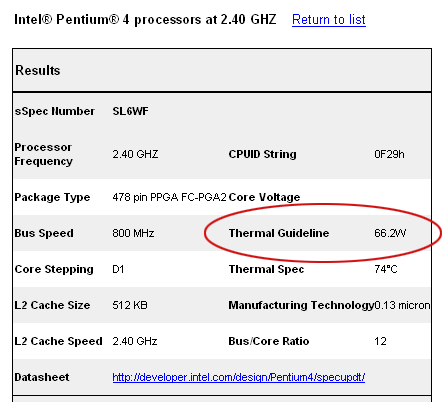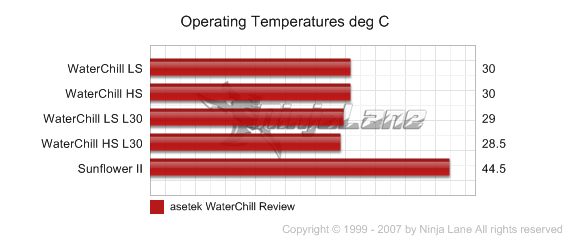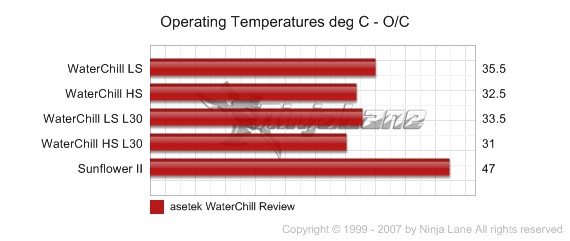After careful consideration I have decided to transfer all hardware review activities to a new domain. I purchased Hardwareasylum.com in 2012 and have been working hard to build a new and improved Ninjalane on that domain. If you are reading this you have reached one of the archived articles, news, projects and/or reviews that were left behind during the site migration.
Please update your bookmarks and be sure to visit the new and improved Ninjalane at Hardwareasylum.com
asetek WaterChill Review
Author: Dennis Garcia
Published: Saturday, November 08, 2003
Benchmarks
The system as it was tested
The asetek WaterChill is designed for use on all kinds of systems though for this set of benchmarks we will focus on the Pentium 4. Here is an overview of the system and testing methodology.
LanParty Pro875 Rev-A
Intel Pentium 4 2.4C (SL6EF)
asetek WaterChill CPU block, L20 and L30 pump running filtered tap water.
AVC Sunflower II
I used the included BIOS monitoring software to obtain temperature information from the system. A game of Halo provided the 100% processor usage.
LanParty Pro875 Rev-A
Intel Pentium 4 2.4C (SL6EF)
asetek WaterChill CPU block, L20 and L30 pump running filtered tap water.
AVC Sunflower II
I used the included BIOS monitoring software to obtain temperature information from the system. A game of Halo provided the 100% processor usage.
Editors note: Even though the Windows XP task manager reported 100% processor usage we could never attain a 100% of the rated heat output as documented by Intel (see below)
when using Halo as a basis for that heat production. Knowing this the game was played until the maximum temperature was attainted and stabilized.
Other things to consider when judging software induced heat output.
a) Clock throttling by the processor at high temperatures.
b) Normal software isn't designed to produce maximum heat output.
c) Variances of cooling temperature.
d) Variances in CPU load.
e) Inaccuracies in thermal diode readouts.
Of course the list goes on..
My testing methodology is aimed to provide a real world look into this watercooler given the test system provided.
a) Clock throttling by the processor at high temperatures.
b) Normal software isn't designed to produce maximum heat output.
c) Variances of cooling temperature.
d) Variances in CPU load.
e) Inaccuracies in thermal diode readouts.
Of course the list goes on..
My testing methodology is aimed to provide a real world look into this watercooler given the test system provided.

Normal Speed

A C/W rating can quickly be calculated using this formula.
C/W = (CPU temp - Ambient temp)/(Variance(%) * CPU Watts)
Allowed variance for this test = 90%
CPU Watts = 66.2W
Using L20 LS Temp = 30C
0.09 C/W = (30C - 24.5C)/(.90(66.2W))
C/W = (CPU temp - Ambient temp)/(Variance(%) * CPU Watts)
Allowed variance for this test = 90%
CPU Watts = 66.2W
Using L20 LS Temp = 30C
0.09 C/W = (30C - 24.5C)/(.90(66.2W))
Overclocked

For this next test the FSB was cranked up to 250Mhz and the test was re-run. To calculate how the C/W rating has changed we will need to factor in the increased processor
wattage. The formula and constants for this is listed below.
ocC/W = dCPU Watts * (ocMhz / dMhz) * (ocVcore / dVcore)2
ocMhz = 3000
dMhz = 2400
ocVcore = 1.60
dVcore = 1.525
The variance still applies for our C/W calcuation
Allowed variance for this test = 90%
CPU Watts = 85.9W
Using L20 LS Temp = 35.5C
0.13 C/W = (35.5C - 24.5C)/(.90(91W))
ocC/W = dCPU Watts * (ocMhz / dMhz) * (ocVcore / dVcore)2
ocMhz = 3000
dMhz = 2400
ocVcore = 1.60
dVcore = 1.525
The variance still applies for our C/W calcuation
Allowed variance for this test = 90%
CPU Watts = 85.9W
Using L20 LS Temp = 35.5C
0.13 C/W = (35.5C - 24.5C)/(.90(91W))
Benchmark Conclusion
As you can see the asetek WaterChill can remove a great deal of heat rather efficiently. Based on the spread of temperatures between the various combinations it would seem that the sweet spot is either using the L20 pump with a 12v fan or the L30 pump with a 7v fan.
Keep in mind this calculation is provided for demonstration purposes only and may not reflect the actual lab tested C/W rating, but I think I'm close
Keep in mind this calculation is provided for demonstration purposes only and may not reflect the actual lab tested C/W rating, but I think I'm close

